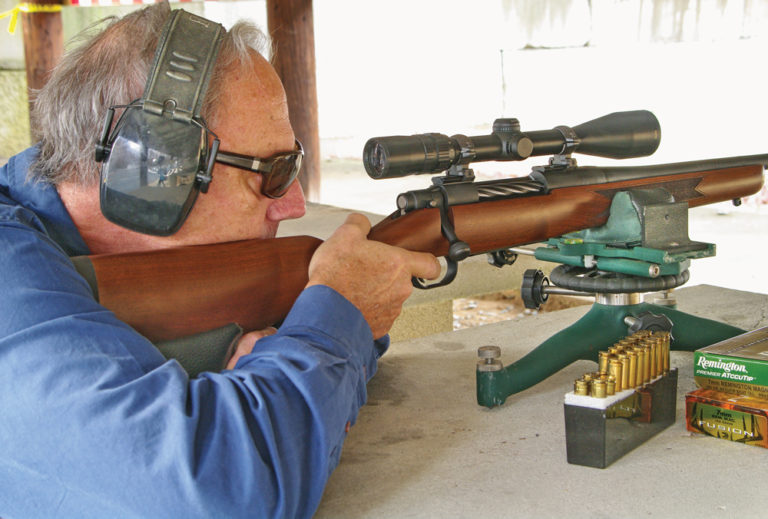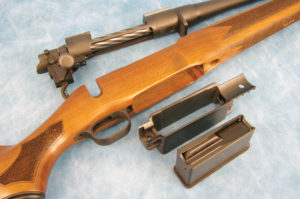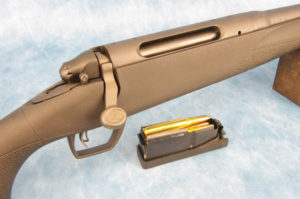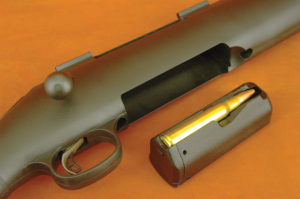
What does $450 get you in today’s world? A mighty fine hunting rifle, that's what.
I don’t know who it was or when some advertising guru came up with the euphemism “value priced,” but you gotta admit, it’s a kind way of delineating products designed for those to whom price is of paramount consideration. I mean, it does sound better than cheap, inexpensive, budget or entry level, doesn’t it?
We’ve now got a gaggle of bolt-action centerfire rifles to which the term “value priced” can be applied, and for this piece we’ve set the limit to rifles with an MSRP under $450. Granted, it’s an arbitrary figure, but it’s also a realistic one. As such, we’re talking the Mossberg Patriot, Remington 783, Ruger American and Savage Axis.
Interestingly enough, late last year, two rifles that would have been included here were discontinued—Marlin’s X7 and Remington’s 770. I can see Remington not wanting to have two budget-class rifles competing with one another in the same market niche, but Marlin’s dropping of the X7 is a bit more baffling because it was as solid a rifle as any of the others. I’m just spit-balling now, but I suspect the reason the X7 didn’t gain traction in the marketplace was a matter of the public’s perception tying Marlin so closely to the traditional lever-action rifle. The X7 represented Marlin’s second unsuccessful attempt in the last 20 years to break out of that mold.

Mossberg Patriot
New for 2015, the Patriot is simply the existing Model 4×4 with a new and much improved stock and a new bolt handle. Also new is that the .375 Ruger chambering has been added to the caliber lineup, a first for Mossberg and a step that bestows true big-game credibility to the line.
Like the other rifles we’re reviewing here, the Patriot is designed for ease and economy of production. As such, it employs a tubular receiver, a barrel lock nut and a separate, washer-type recoil lug sandwiched between the receiver and the barrel lock nut. This same arrangement is also seen on Remington’s 783. While all four rifles under discussion here employ a barrel lock nut, as we shall see, the Ruger American and the Savage Axis do not use the washer-type recoil lug.

There are no flats or facets milled into the receiver, as seen on so many other tubular-receiver rifles, to disguise the fact that it is essentially nothing more than a straight tube with an ejection port and a cut-out in the floor for the magazine. The bolt is comprised of three components: the spiral fluted body to which a separate, floating bolt head is crosspinned at the front end, and a handle collared onto it at the rear. The crosspin that holds the bolt head to the body has a hole in its center to allow passage of the firing pin. This crosspin arrangement allows a few thousandths of an inch of lateral play in the locking lugs so that they self seat, as it were, against their abutment surfaces. It accomplishes the same thing as hand lapping the lugs and a lot less expensively.
The recessed bolt face hosts the familiar plunger-type ejector, while the extractor slides radially within a T-slot at the front of the right-side locking lug. An anti-bind groove in that same right-side locking lug contributes to smooth, wobble-free bolt travel. Mossberg’s LBA trigger is user-adjustable from 2-7 pounds, though I can’t imagine anyone wanting a trigger even close to 7 pounds.
The stock is the biggest change and what really separates the Patriot from the previous 4×4 models; let’s face it, they were downright ugly! The unique bedding system of the 4×4 however, remains unchanged, in that there is a one-piece polymer bedding platform for the receiver that also serves as the well for the detachable magazine. This bedding chassis, if you will, simply drops down into the stock and is not permanently mated to it. This same assembly is found in all three stock types offered for the Patriot—an injection molded synthetic, a traditional walnut stock and a wood laminate.
One of the real strong points of the Patriot is its excellent detachable magazine; it’s one piece of molded polymer with integral feed lips. It’s feather light, virtually indestructible and one of the easiest loading we’ve ever encountered. The one thing about this gun we don’t like is the unsightly protuberance sticking out on the left side of the bolt shroud. It’s a safety thing meant to preclude replacing a decocked bolt back into the receiver, in which case the firing pin would be protruding. In the event a live round was chambered, a forceful push on the bolt could cause ignition with an unlocked bolt. There are other ways to preclude such an event that are far more acceptable both mechanically and cosmetically.
The Patriot is offered in 11 calibers ranging from .22-250 to .375 Ruger. Prices range from $386 for the synthetic stocked version, to $584 for the black/gray wood laminate model with Marinecote metal finish. Pre-mounted Weaver-type scope mount bases are included. www.mossberg.com

Remington 783
What’s already been said about the Mossberg Patriot’s bolt design and fabrication, barrel fitment and receiver can also be said of this rifle, right down to the same extraction, ejection and anti-bind slot at the lower edge of the right locking lug. The bolt shroud, however, is much more attractive on this rifle. Even the bolt stop/release is exactly the same—a pivoting, one-piece blade of sheet steel with an upward extension that juts up just behind the left side of the receiver bridge. A forward push pivots the front end downward out of the left lug raceway allowing bolt removal. It doesn’t get any simpler… or more efficient.

The ejection port is of minimal dimensions, which makes this receiver substantially more rigid than most bolt actions that have far more material removed from the top half than necessary. Such wide ports were needed on military guns to accept charger clips and for loading fixed magazines from above, but most of the newer bolt actions have detachable boxes, so those are no longer needed.
The trigger is Remington’s user-adjustable CrossFire, which is housed in a robust nonferrous casting that’s bolted to the receiver. It has a range of 2.5-5 lbs. and is conceptually similar to Savage’s Accutrigger, Ruger’s Marksman and Mossberg’s LBA. A two-position side safety blocks trigger movement but does not lock the bolt. The bolt stop/release is virtually identical to that described for the Mossberg Patriot, i.e., a one-piece pivoting blade.
The detachable magazine, which sits absolutely flush with the belly of the stock, is a sheet metal box with a polymer boot. The release lever is part of the magazine, not the stock, which we prefer. The stock itself is quite handsome despite the fact that the shape of the fore-end tip and triggerguard bow are not mainstream. The swivel attachments are molded into the stock, but the triggerguard bow is a separate component. On most other budget rifles with molded stocks, the guard bow is integral.
While several rifles on the market claim to be pillar bedded, the 783 truly is. The only contact points for the entire barreled action are the two aluminum pillars through which the action screws pass; their top surface is about .025 inches higher than the area surrounding them. At the butt end is Remington’s SuperCell recoil pad that does a good job of attenuating felt recoil. All in all, the 783 is a sound, good-looking rifle at a rather astounding price. Consider that in 2015 it will be sold only as a package rifle with a pre-mounted and bore-sighted 3-9×40 scope at the almost unbelievable MSRP of $399 in all calibers. That means that realistic street price will be somewhere around $340! Chamberings offered are .223, .22-250, .243 and .308 in the short action and .270, .30-06, 7mm Rem. and .300 Win. Magnums in long. www.remington.com

Ruger American
Unlike the other three guns under review here, this is not a Mauser-type twin-lug action requiring a 90-degree bolt rotation. Rather, it’s of the “fat bolt” school that employs a larger than normal bolt with forward locking lugs that are formed by machining away material at the head. In other words, measured across the locking lugs, the diameter is the same as that of the bolt body behind.
So, instead of two opposed locking lugs, the one-piece American bolt has three, oriented on 120-degree centers, and, as such, require only a 70-degree handle lift. Dual cocking cams reduce the effort required to cycle the action, which with a shouldered gun makes reloading easier. The recessed bolt face houses the ubiquitous plunger ejector and an extractor very similar to the others in that it slides radially within a T-slot housed in the face of the right side locking lug. The bolt stop/release serves a third function in that it rides a lengthwise groove in the bolt body to prevent free rotation of the bolt when out of battery. Such an arrangement is necessary on fat-bolt actions because there are no protruding locking lugs riding raceways within the receiver.

Instead of employing a washer-type recoil lug, two steel V-blocks embedded into the stock fore and aft of the magazine well engage matching grooves in the underside of the receiver. It’s a clever and very efficient way to transmit recoil to the stock, as well as providing a bedding surface for the receiver. The barrel is, of course, free floating. The receiver is tubular, but two lengthwise facets milled at the 2 and 10 o’clock positions dispel that impression. Like the 783, the ejection port is just large enough to fulfill its function.
The one-piece polycarbonate magazine is among the very best we’ve seen on any rifle, domestic or foreign, regardless of price. It’s a rotary type whereby the spring-loaded follower rotates around a shaft on the left side of the box. As cartridges are loaded, the follower backs up, storing them in a “C” orientation. The bottom of the magazine fits absolutely flush with the belly of the stock and is of matching contour. The trigger is Ruger’s Marksman, which is user-adjustable from 3-5 pounds. The two-position top tang safety is as ergonomic as it gets; when engaged, it blocks trigger movement.
The American is offered in seven standard calibers ranging from the .223 Rem. to .30-06. If in the future it were to be chambered for magnum calibers, some major changes would have to be made to the bolt because the rim of the recessed face is too thin for the enlargement necessary to accommodate a .532-inch rim diameter. The American carries an MSRP of $449, which includes pre-mounted Weaver-type scope bases. www.ruger.com

Savage Axis
It is somewhat ironic that the Axis series, which is Savage’s least expensive centerfire rifle, shares a feature found only on the company’s most expensive target/varmint and competition rifles: a minimal-size ejection port. Another unique feature on the Axis is a large scallop machined into the left side of the receiver, which reduces weight and lends some visual interest to what otherwise would be a straight tube.
Yet another difference between this gun and Savage’s flagship Model 100-series (as well as all other domestic bolt-action rifles), is that there is no integral rear tang on the receiver. Normally, the rear tang anchors the trigger assembly and has a deep notch machined into its right side into which the root of the bolt handle lowers, thus acting as a non-bearing auxiliary safety lug in case of a catastrophic failure. On this rifle, the receiver bridge ends abruptly, and what looks like a rear tang is actually an extension of the trigger housing. Though a different arrangement, the end result is the same tang-mounted safety as found on all Savage 100-series rifles, except that the Axis has a two-position rather than a three-position safety.

With the barreled action removed from the stock, other differences between the 100-series rifles can be seen, differences that cut production costs without materially affecting mechanics or performance. The bolt cap and handle are different, as is the magazine geometry, and the triggerguard is a separate sub-assembly of the injection-molded polymer stock. Instead of the washer-type recoil lug sandwiched between the barrel and receiver, a steel plate is embedded in the stock that engages a slot on the underside of the receiver. Both methods are equally effective.
We don’t like everything about this rifle, particularly the stock—it’s way too thin in the wrist even for our small hands, and the fore-end is too slender as well. The magazine works well enough and fits perfectly flush with the belly of the stock, but it’s stamped from sheet stock that’s not much thicker than a soup can. But again, none of these affect the rifle’s accuracy or function.
The Axis is available in standard calibers ranging from the .204 Ruger to .30-06 at an MSRP of $362.
www.savagearms.com
All four of the rifles reviewed here have more in common than just being value priced—all are embarrassingly accurate! I say that because you can spend double or more for each company’s flagship rifle and have them not shoot any better. Granted, you give up some degree of refinement like fit, finish, materials and caliber choice, but if you’re interested in performance as well as price, you can’t go wrong choosing any one of them.

Next Step: Get your FREE Printable Target Pack
Enhance your shooting precision with our 62 MOA Targets, perfect for rifles and handguns. Crafted in collaboration with Storm Tactical for accuracy and versatility.
Subscribe to the Gun Digest email newsletter and get your downloadable target pack sent straight to your inbox. Stay updated with the latest firearms info in the industry.

![Best Concealed Carry Guns In 2025 [Field Tested] Wilson Combat EDC X9S 1](https://gundigest.com/wp-content/uploads/Wilson-Combat-EDC-X9S-1-324x160.jpg)


![Best 9mm Carbine: Affordable PCCs [Tested] Ruger Carbine Shooting](https://gundigest.com/wp-content/uploads/Ruger-Carbine-Shooting-100x70.jpg)
![Best AR-15: Top Options Available Today [Field Tested] Harrington and Richardson PSA XM177E2 feature](https://gundigest.com/wp-content/uploads/Harrington-and-Richardson-PSA-XM177E2-feature-100x70.jpg)

Needed something in 30.06 to mount a Photon night sight that was reasonably accurate. Didn’t want to use any of my HS Precision rifles or 700’s so went on a budget bolt toggle hunt. Liked the Ruger American but hate the bolt on my GSR (can be sticky on a quick cycle) so kinda ruled that out. Remember the 770 and that was a real dog. Don’t get me wrong the 700 is a great rifle and I love mine (magnum riveted extractor can be problematic though) but lots of corners were cut on their last budget outing and made me gun shy. Ruled out the 783. Then I happened on the Patriot and the killer reviews it was getting. Went down to Sportsman’s Warehouse and checked one out. Really light. Felt well balanced and shouldered really nice with a Monte Carlo type cheek riser in the stock. The boll. Wow! Smooothhh! Gun just felt right and Sportsman’s sold out for a great price. Had to get a new picatinny rail from EGW. Waiting on it to mount night scope but I’m anticipating a really nice shooter. Will update after zero and some 200 yard groups.
I am familiar with both the Ruger American Compact and the Savage Axis. Both are accurate hunting rifles, with offerings in the cartridges that can ethically take game at distances within a practiced shooters ability. The firearm industry, led by Savage in the mid 2000’s, began providing feature filled, quality bolt action firearms at reasonable cost. Others with which I am familiar is the Weatherby Vanguard (though their pricing has been edging beyond entry level), Stevens 200 (no longer produced by Savage), and the TC Venture. Mossberg has long produced reasonable cost entry level firearms, I own and shoot a WW II vintage 22 caliber Mossberg with aperture sights that my father purchased in the 40’s. Hopefully Winchester will provide a quality, entry level centerfire again, but the others you have mentioned seem to have fulfilled the market demand as of now.
It is nice that these guns are available at a reasonable price, but I didn’t notice you mentioning that any of them were available in a left-handed version. Do any of them come made for us lefties?